Simulation of VVER-1000 Guillotine Large Break Loss of Coolant Accident Using RELAP5/SCDAPSIM/MOD3.5
Abstract
1. Introduction
2. Materials and Methods
2.1. Brief Description of VVER-1000 Reactor
2.2. Layout of the VVER1000 Primary Components
2.3. LARGE LOCA Accident Analysis in VVER-1000
3. RELAP/SCDAPSIM in Nuclear Power Plants
Qualification of RELAP5/SCDAPSIM/MOD3.5 as a Computational Tool
4. Research Accident Scenario Description and Modelling
4.1. The Event Causes and Identification
4.2. Interpretation of the LB-LOCA Scenario in VVER-1000
4.3. Plant Geometrical Modelling
4.4. Nodalization of Safety Systems
4.5. Nodalization Qualification
4.6. LOCA Modelling
4.7. Initial and Boundary Conditions
4.8. Steady State Qualification Level
4.9. Transient Qualification Level
5. Results and Discussion
5.1. Model Validation
5.2. Study Steady State Results
5.3. Analysis of the RELAP5/SCDAPSIM/MOD3.5 Results
6. Study Novelty
7. Conclusions
Author Contributions
Funding
Institutional Review Board Statement
Informed Consent Statement
Data Availability Statement
Acknowledgments
Conflicts of Interest
References
- Kim, J.; Park, S.Y.; Il Ahn, K.; Yang, J.E. IROCS: Integrated accident management framework for coping with beyond-design-basis external events. Nucl. Eng. Des. 2016, 298, 1–13. [Google Scholar] [CrossRef]
- Gjorgiev, B.; Volkanovski, A.; Sansavini, G. Improving nuclear power plant safety through independent water storage systems. Nucl. Eng. Des. 2017, 323, 8–15. [Google Scholar] [CrossRef]
- International Atomic Energy Agency. IAEA SAFETY STANDARDS SERIES Safety of Nuclear Power Plants: Design; International Atomic Energy Agency: Vienna, Austria, 2000; Volume NS-R-1. [Google Scholar]
- Kurakov, Y.A.; Dragunov, Y.G.; Fil, N.S.; Krushelnttsky, V.N.; Berkovich, V.M.; Federation, R. Improvement of operational performance and increase of safety of WWER-1000/V-392. In Proceedings of the Technical Committee Meeting on Performance of Operating and Advanced Light Water Reactor Designs, Munich, Germany, 23–25 October 2000; IAEA: Vienna, Austria, 2001; pp. 143–154. Available online: https://www.osti.gov/etdeweb/biblio/20198946 (accessed on 10 October 2021).
- International Atomic Energy Agency. Accident Analysis for Nuclear Power Plants with Pressurized Water Reactors; Safety Reports Series No. 30; International Atomic Energy Agency: Vienna, Austria, 2003; p. 65. [Google Scholar]
- International Atomic Energy Agency. Assessment of Defence in Depth for Nuclear Power Plants; Safety Reports Series No. 46; International Atomic Energy Agency: Vienna, Austria, 2005. [Google Scholar]
- ARIS. Status Report 93-VVER–1000; ARIS: Vinenna, Austria, 2011; Volume 1000. [Google Scholar]
- Kumar, A. Application of RELAP/SCDAPSIM for Severe Accident and Safety Analysis of Nuclear Reactor Systems. Ph.D. Thesis, Indian Institute of Technology New-Delhi India, Kanpur, India, 2016. [Google Scholar]
- Borisov, E.; Grigorov, D.; Mancheva, K. Study of long-term loss of all AC power supply sources for VVER-1000/V320 in connection with application of new engineering safety features for SAMG. Ann. Nucl. Energy 2013, 59, 204–210. [Google Scholar] [CrossRef]
- Mohsendokht, M.; Hadad, K.; Jabbari, M. Reducing the loss of offsite power contribution in the core damage frequency of a VVER-1000 reactor by extending the house load operation period. Ann. Nucl. Energy 2018, 116, 303–313. [Google Scholar] [CrossRef]
- Volkanovski, A.; Prošek, A. Extension of station blackout coping capability and implications on nuclear safety. Nucl. Eng. Des. 2013, 255, 16–27. [Google Scholar] [CrossRef]
- Jabbari, M.; Hadad, K.; Pirouzmand, A. Re-assessment of station blackout accident in VVER-1000 NPP with additional measures following Fukushima accident using Relap/Mod3.2. Ann. Nucl. Energy 2019, 129, 316–330. [Google Scholar] [CrossRef]
- Pavlova, M.P.; Groudev, P.P.; Stefanova, A.E.; Gencheva, R.V. RELAP5/MOD3.2 sensitivity calculations of loss-of-feed water (LOFW) transient at Unit 6 of Kozloduy NPP. Nucl. Eng. Des. 2006, 236, 322–331. [Google Scholar] [CrossRef]
- Yousif, E.; Zhang, Z.; Tian, Z.; Ju, H.R. Simulation and Analysis of Small Break LOCA for AP1000 Using RELAP5-MV and Its Comparison with NOTRUMP Code. Sci. Technol. Nucl. Install. 2017, 2017, 4762709. [Google Scholar] [CrossRef]
- Dwiddar, M.S.; Badawi, A.A.; Abou-Gabal, H.H.; El-Osery, I.A. From VVER-1000 To VVER-1200.Investigation of the Effect of the Changes in Core. In Proceedings of the PHYTRA 3—The Third International Conference on Physics and Technology of Reactors and Applications, Tetouan, Morocco, 12–14 May 2014. [Google Scholar]
- Vojackova, J.; Novotny, F.; Katovsky, K. Safety analyses of reactor VVER 1000. Energy Procedia 2017, 127, 352–359. [Google Scholar] [CrossRef]
- Heralecky, P. International Agreement Report: Post-Test Analysis of Upper Plenum 11% Break at PSB-VVER Facility Using TRACE V5.0 and RELAP5/MOD3.3 Code; US Nuclear Regulatory Commission: Rockville, MD, USA, 2014. Available online: https://www.tes.eu/wp-content/uploads/2019/06/Post-test-Analysisof-Upper-Plenum-11-Break_PSB_VVER_TRACE_RELAP.pdf (accessed on 10 August 2021).
- Tarantino, M.; Auria, F.D.; Giorgio, G. Simulation of a large break loca on VVER-1000 npp by RELAP5/MOD3 2 simulation of a large break loca on VVER-1000 NPP. In Proceedings of the ANS/HPS Student Conference Nuclear Engineering, Texas A&M University, College Station, TX, USA, 29–31 March 2001. [Google Scholar]
- Pirouzmand, A.; Ghasemi, A.; Faghihi, F. Safety analysis of LBLOCA in BDBA scenarios for the Bushehr’s VVER-1000 nuclear power plant. Prog. Nucl. Energy 2016, 88, 231–239. [Google Scholar] [CrossRef]
- Tabadar, Z.; Jabbari, M.; Khaleghi, M.; Hashemi-Tilehnoee, M. Thermal-hydraulic analysis of VVER-1000 residual heat removal system using RELAP5 code, an evaluation at the boundary of reactor repair mode. Alexandria Eng. J. 2018, 57, 1249–1259. [Google Scholar] [CrossRef]
- Ryzhov, S.B.; Mokhov, V.A.; Nikitenko, M.P.; Bessalov, G.G.; Podshibyakin, A.K.; Anufriev, D.A.; Gado, J.; Rohde, U. VVER-Type Reactors of Russian Design. In Handbook of Nuclear Engineering; Springer: Berlin/Heidelberg, Germany, 2010. [Google Scholar] [CrossRef]
- Hosseini, S.A.; Shirani, A.S.; Zangian, M.; Najafi, A. Re-assessment of accumulators performance to identify VVER-1000 vulnerabilities against various break sizes of SB-LOCA along with SBO. Prog. Nucl. Energy 2020, 119, 103145. [Google Scholar] [CrossRef]
- Lobner, P. Definition of Baseline VVER-1000 V320 Systems and Evaluation of Plant Response to Postulated Accidents; Science Application International Corporation: San Diego, CA, USA, 1987. [Google Scholar]
- Allison, C.M.; Hohorst, J.K. Role of RELAP/SCDAPSIM in Nuclear Safety. Sci. Technol. Nucl. Install. 2010, 2010, 1–21. [Google Scholar] [CrossRef]
- International Atomic Energy Agency. Best Estimate Safety Analysis for Nuclear Power Plants: Uncertainty Evaluation; Safety Reports Series No. 52; International Atomic Energy Agency: Vienna, Austria, 2008. [Google Scholar]
- Chatterjee, B.; Mukhopadhyay, D.; Lele, H.G.; Ghosh, A.K.; Kushwaha, H.S.; Groudev, P.; Atanasova, B. Analyses for VVER-1000/320 reactor for spectrum of break sizes along with SBO. Ann. Nucl. Energy 2010, 37, 359–370. [Google Scholar] [CrossRef]
- Bucalossi, A.; Petruzzi, A. Role of best estimate plus uncertainty methods in major nuclear power plant modifications. J. Nucl. Sci. Technol. 2010, 47, 671–683. [Google Scholar] [CrossRef][Green Version]
- Sun, D.; Zhang, Z.; Li, X.; Li, L.; Wang, H.; Xu, A.; Chen, S. An Improved Best Estimate Plus Uncertainty Method for Small-Break Loss-of-Coolant Accident in Pressurized Water Reactor. Front. Energy Res. 2020, 8, 1–16. [Google Scholar] [CrossRef]
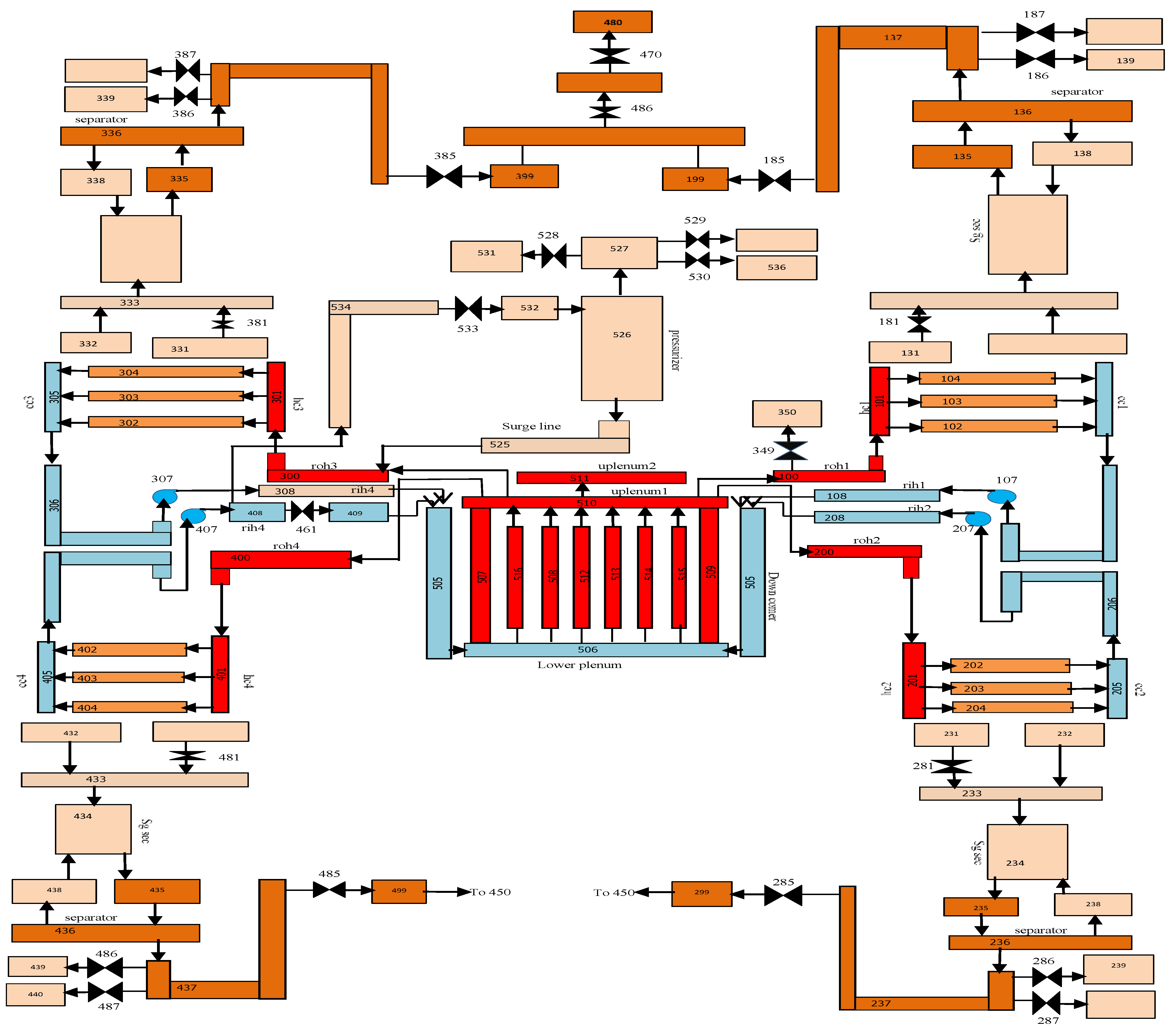


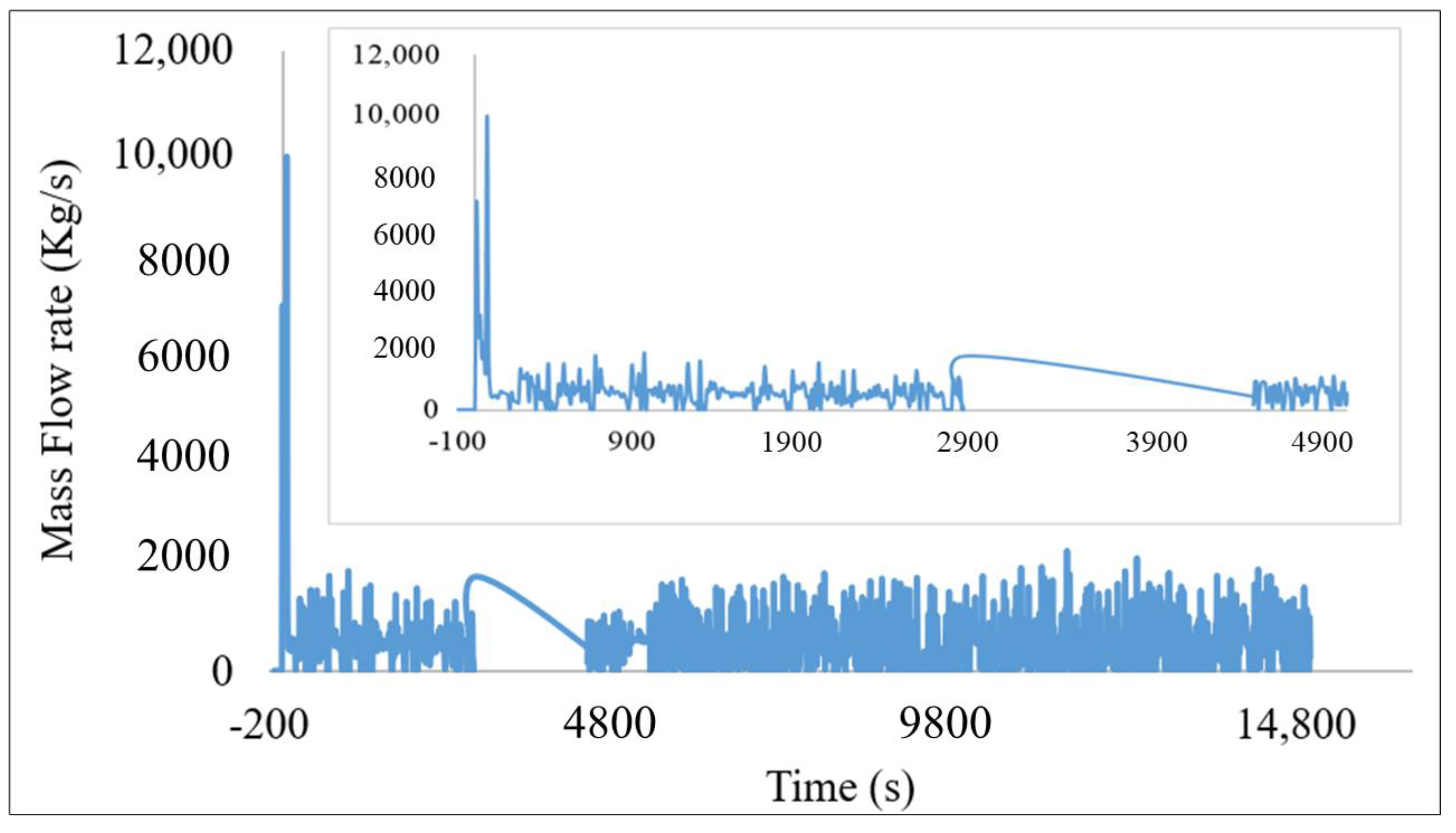
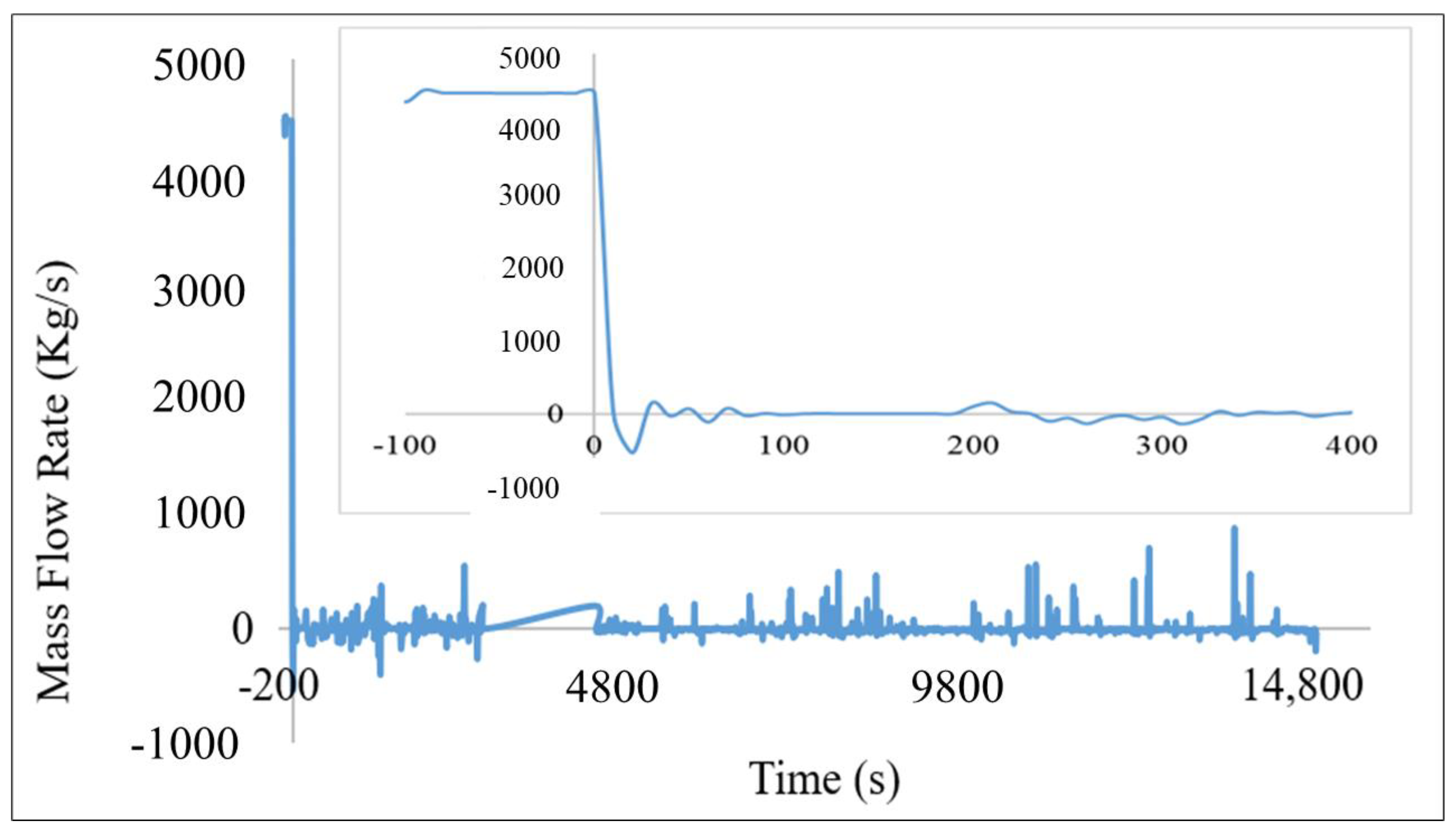

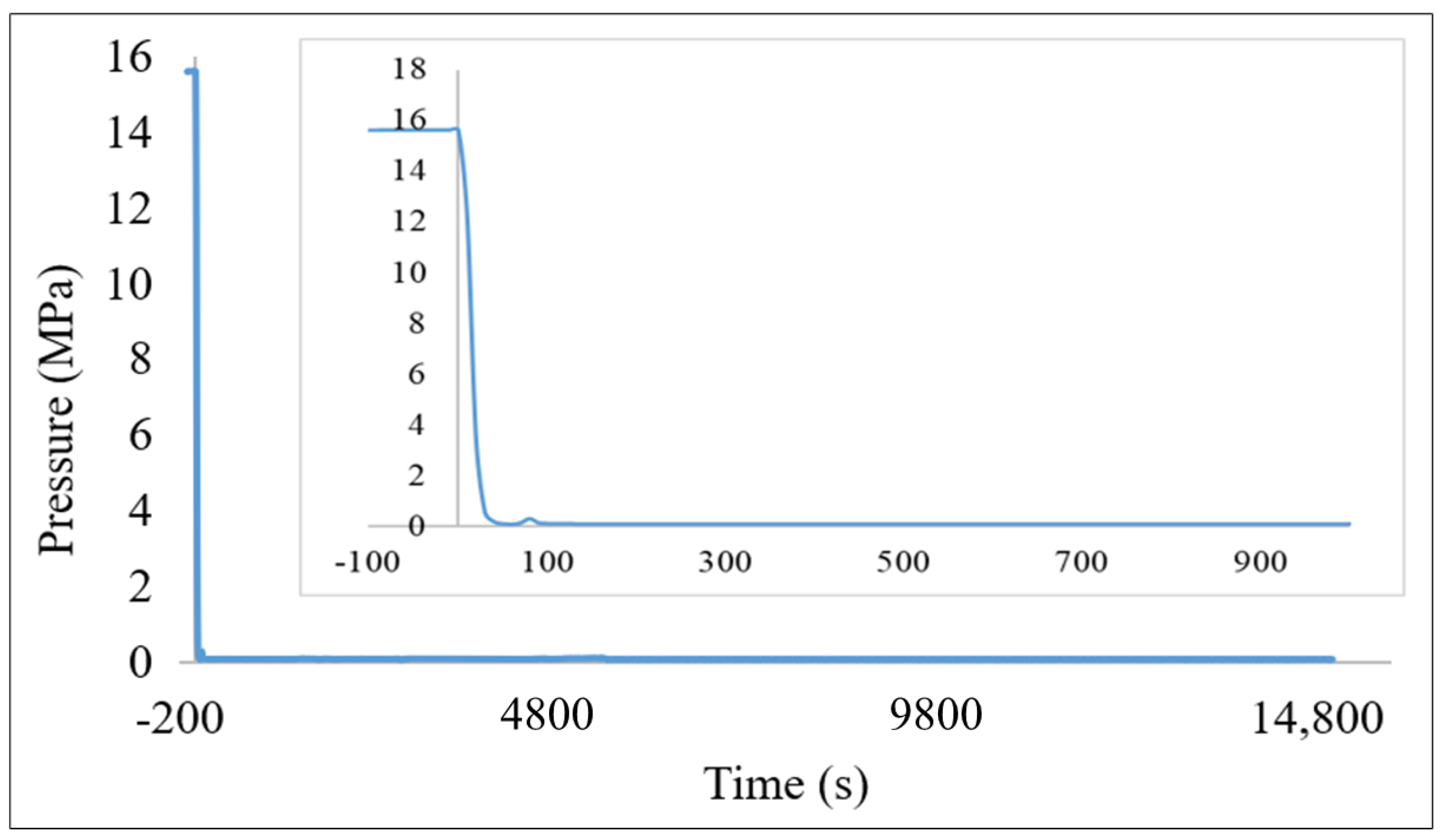
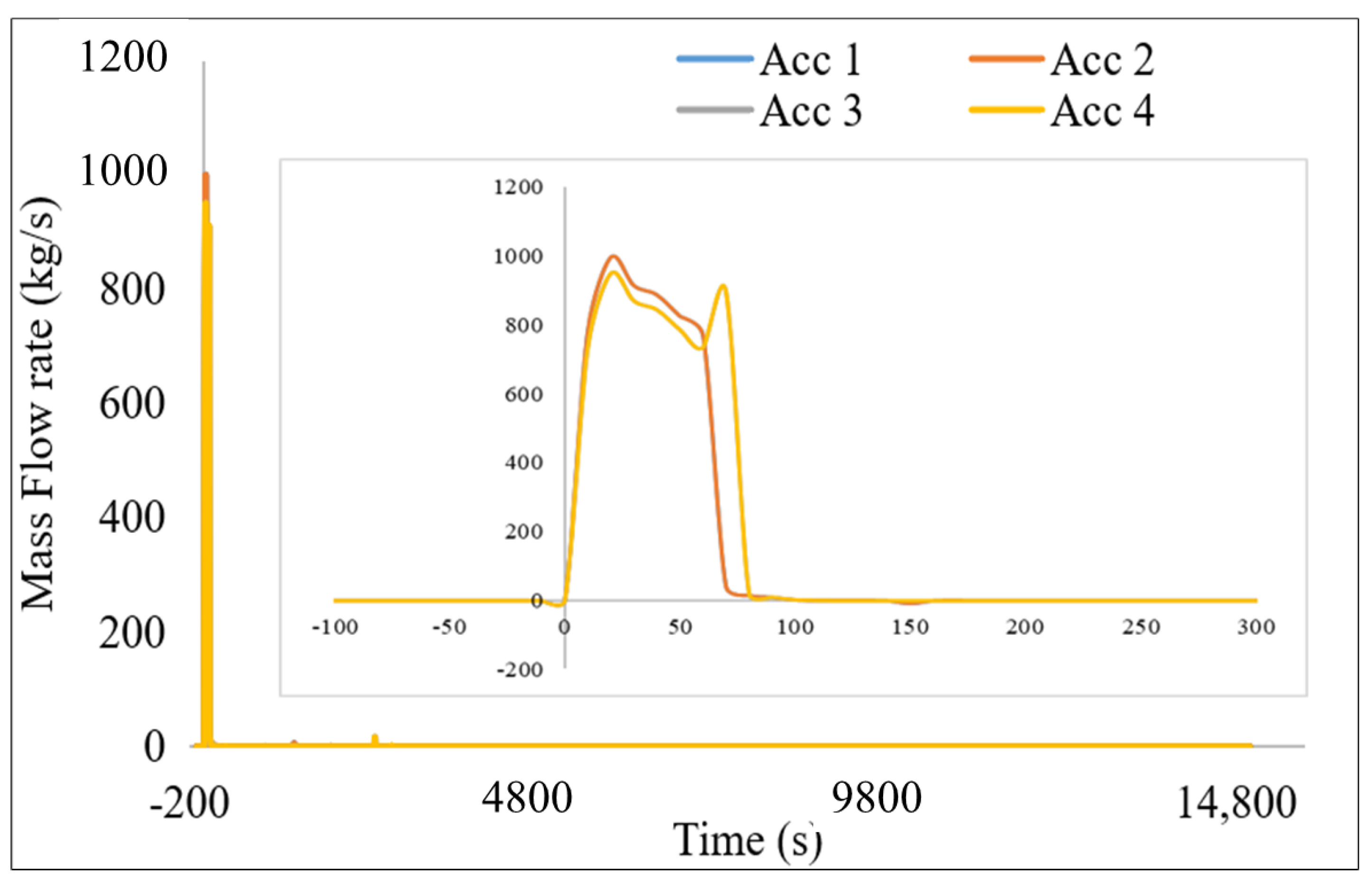
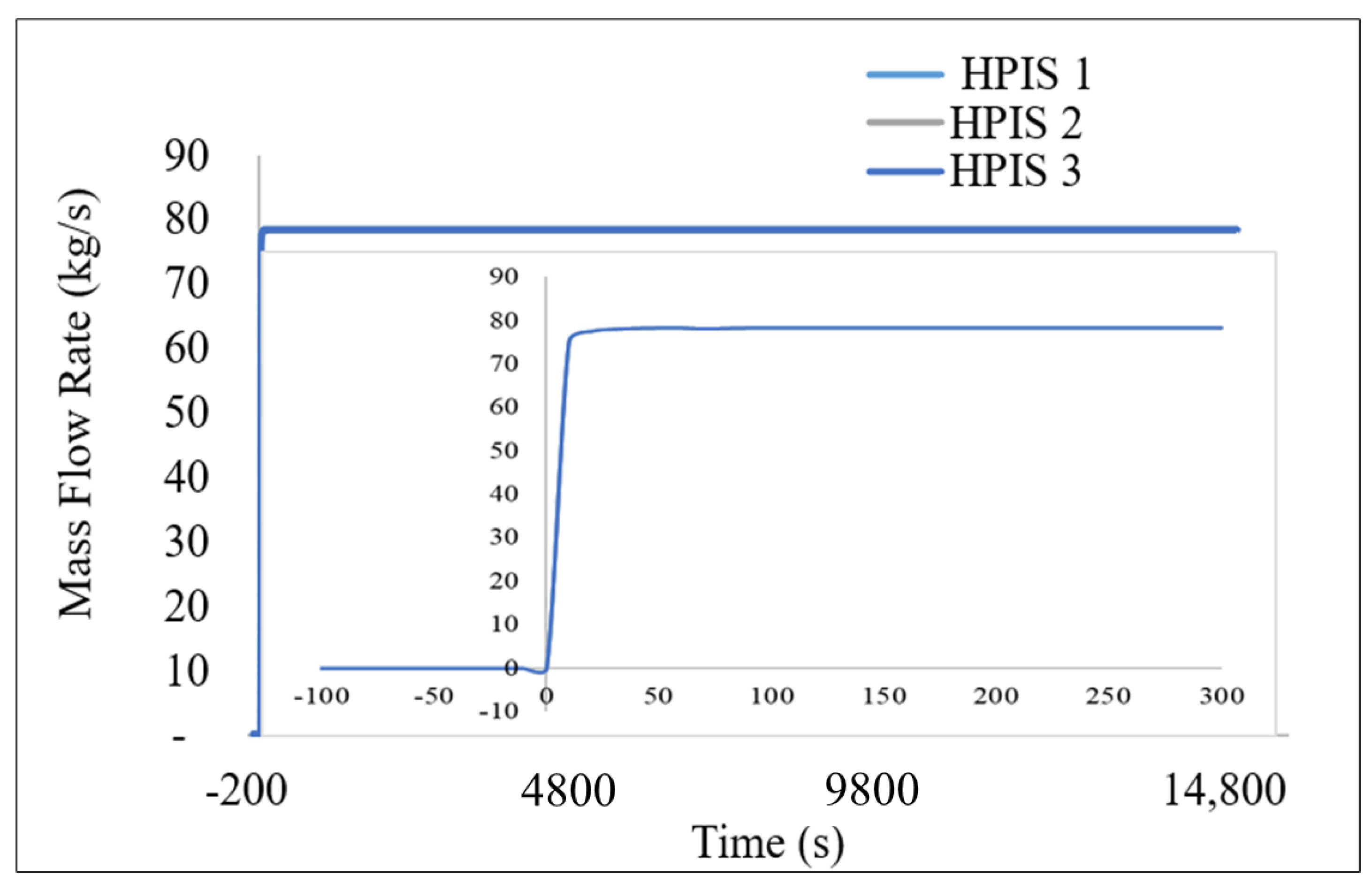
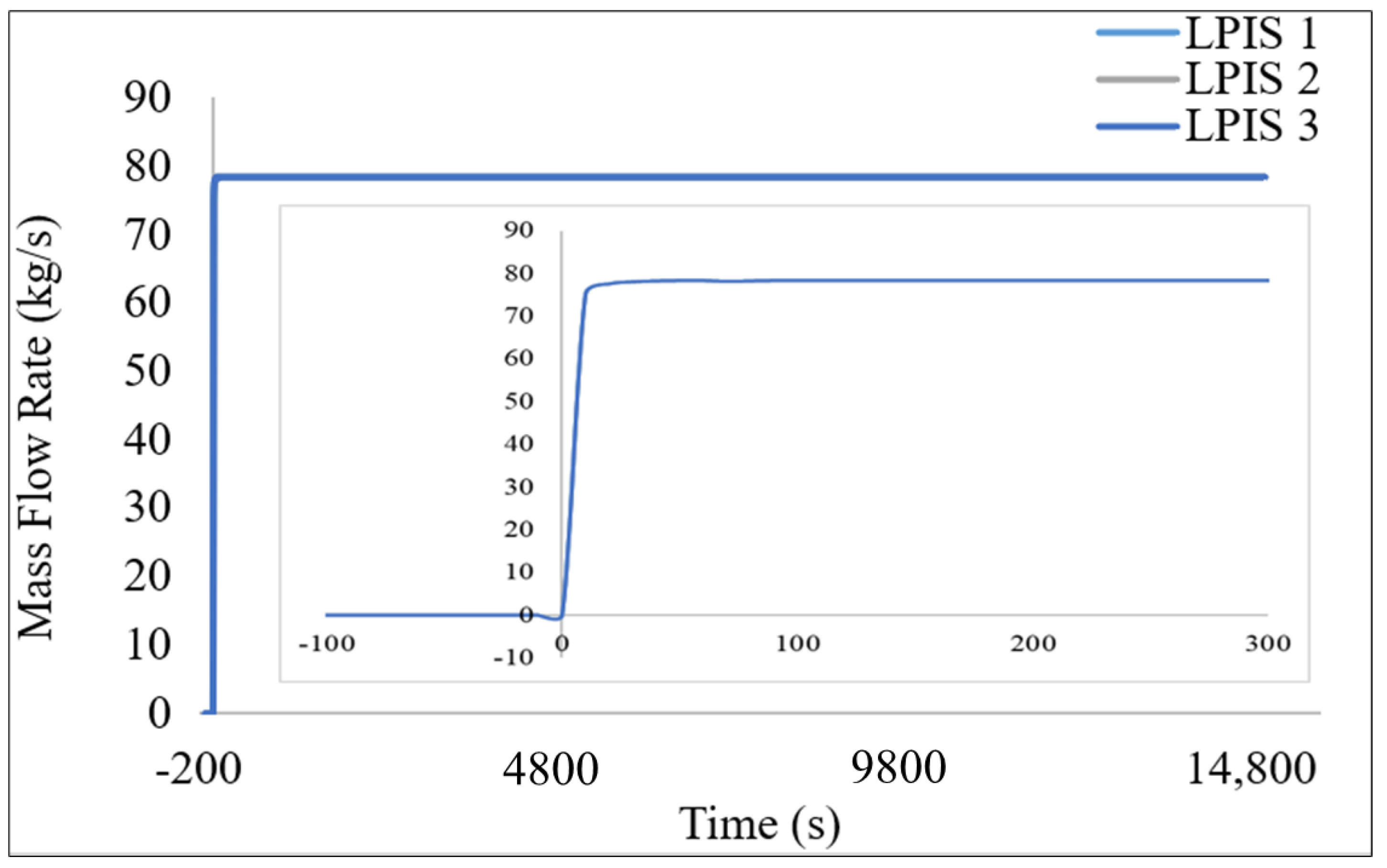
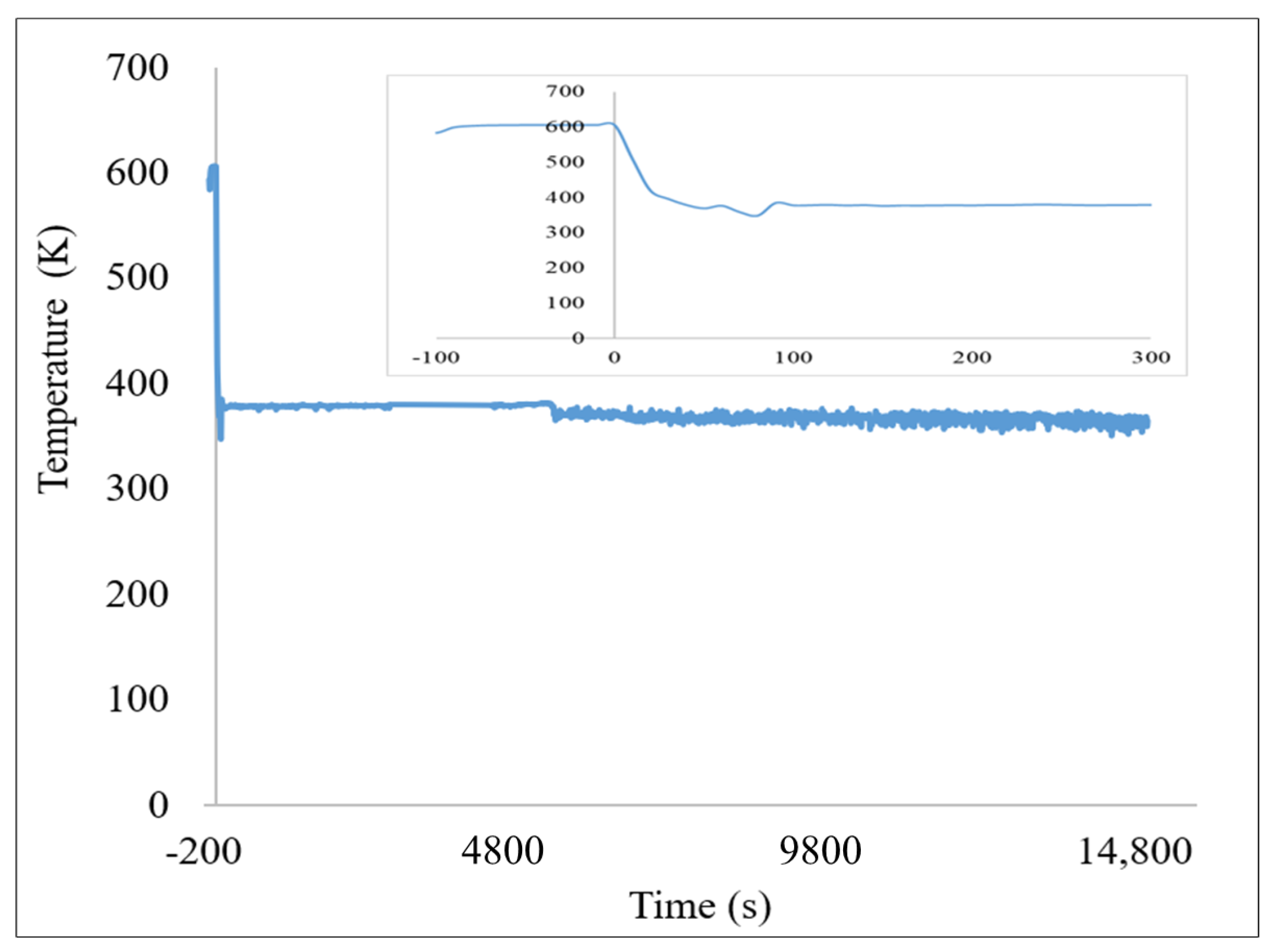

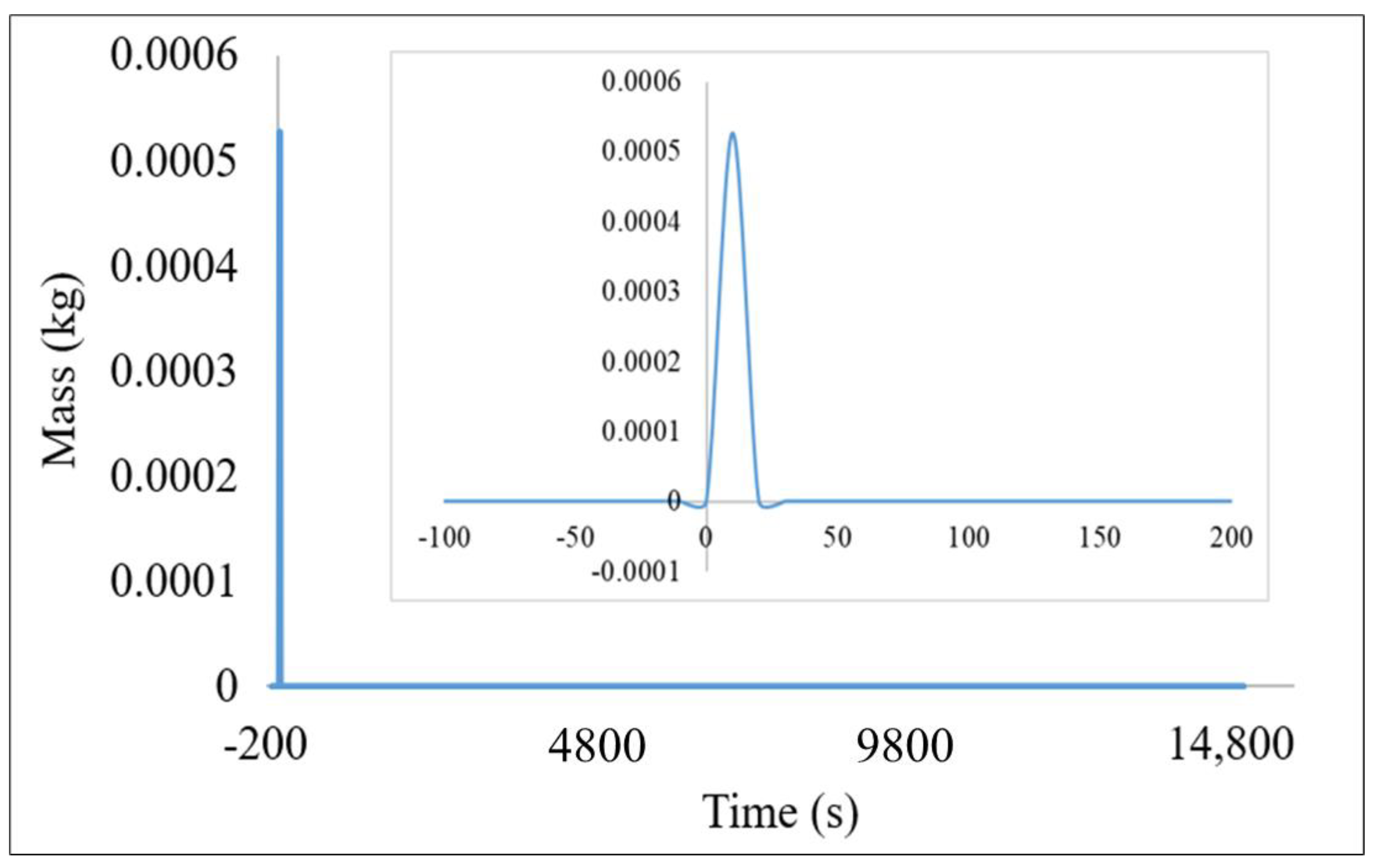
| Safety System Actuation | Time (s) |
|---|---|
| Steady state reactor operation | ≤0 |
| LOCA starts | 0 |
| Reactor trip | 1.6 |
| Generation of “S” signal | 7 |
| Accumulators injection starts | 8.5 |
| Accumulators emptied | 170 |
| HPIS injection starts | 10 |
| LPIS injection starts | 13 |
| PRZ emptying | 50 |
| End of the calculation | 15,100 |
Publisher’s Note: MDPI stays neutral with regard to jurisdictional claims in published maps and institutional affiliations. |
© 2021 by the authors. Licensee MDPI, Basel, Switzerland. This article is an open access article distributed under the terms and conditions of the Creative Commons Attribution (CC BY) license (https://creativecommons.org/licenses/by/4.0/).
Share and Cite
Thulu, F.G.D.; Elshahat, A.; H. M. Hassan, M. Simulation of VVER-1000 Guillotine Large Break Loss of Coolant Accident Using RELAP5/SCDAPSIM/MOD3.5. J. Nucl. Eng. 2021, 2, 516-532. https://doi.org/10.3390/jne2040035
Thulu FGD, Elshahat A, H. M. Hassan M. Simulation of VVER-1000 Guillotine Large Break Loss of Coolant Accident Using RELAP5/SCDAPSIM/MOD3.5. Journal of Nuclear Engineering. 2021; 2(4):516-532. https://doi.org/10.3390/jne2040035
Chicago/Turabian StyleThulu, Fabiano Gibson Daud, Ayah Elshahat, and Mohamed H. M. Hassan. 2021. "Simulation of VVER-1000 Guillotine Large Break Loss of Coolant Accident Using RELAP5/SCDAPSIM/MOD3.5" Journal of Nuclear Engineering 2, no. 4: 516-532. https://doi.org/10.3390/jne2040035
APA StyleThulu, F. G. D., Elshahat, A., & H. M. Hassan, M. (2021). Simulation of VVER-1000 Guillotine Large Break Loss of Coolant Accident Using RELAP5/SCDAPSIM/MOD3.5. Journal of Nuclear Engineering, 2(4), 516-532. https://doi.org/10.3390/jne2040035






